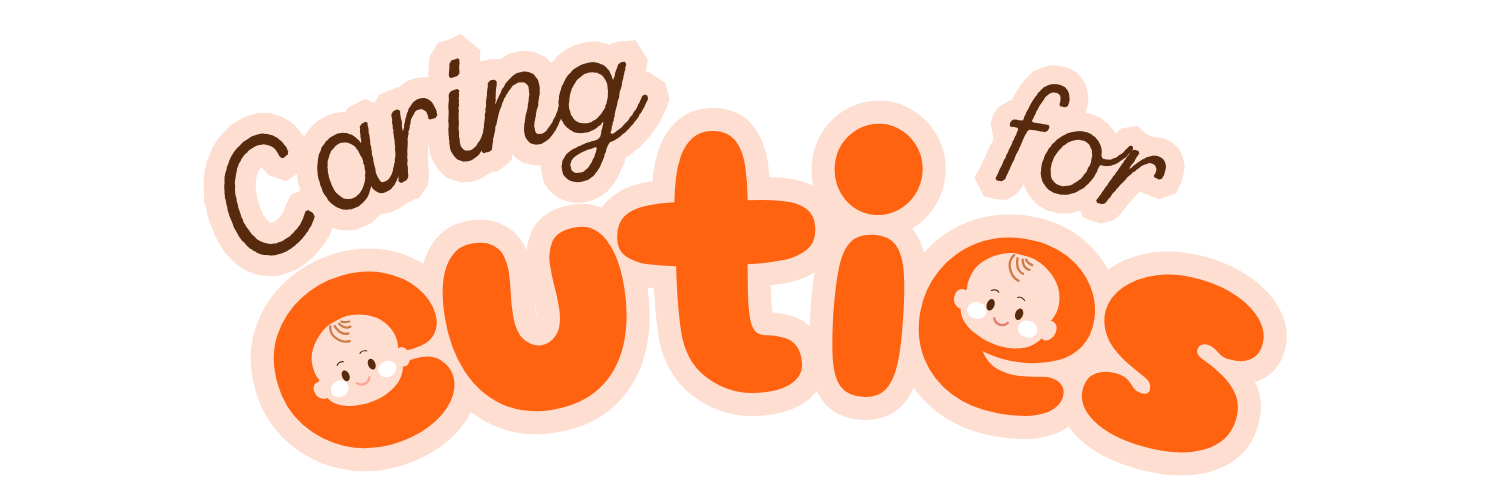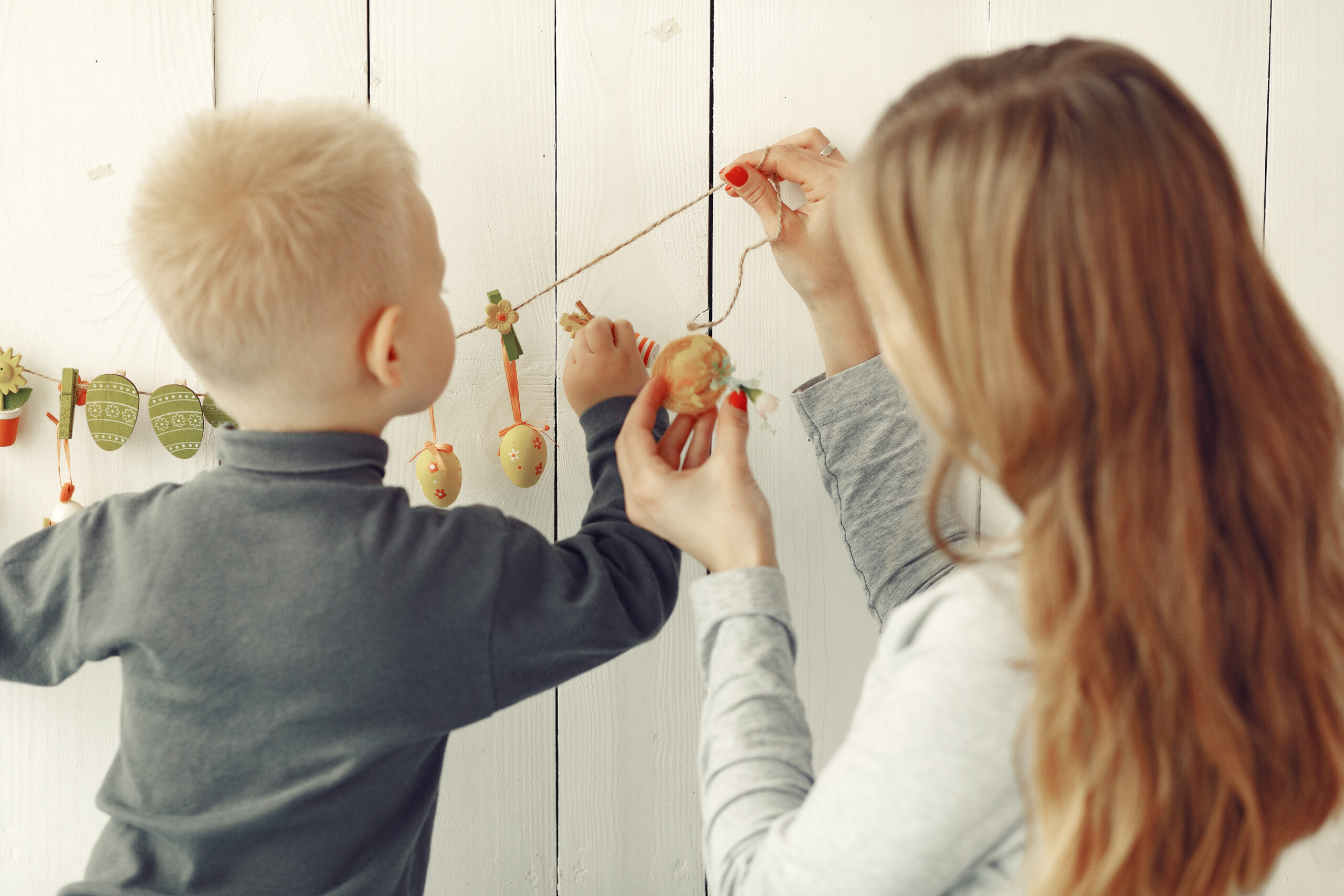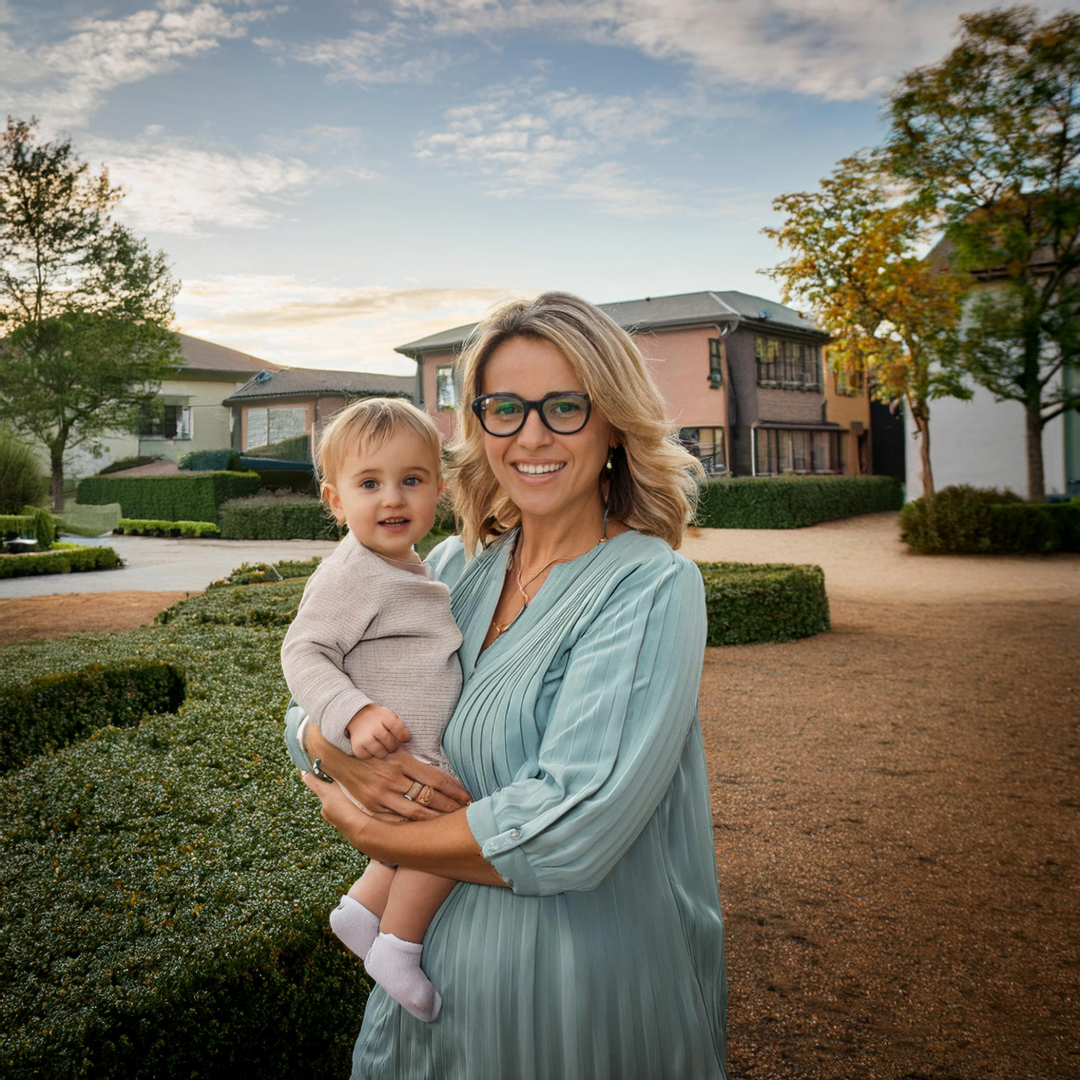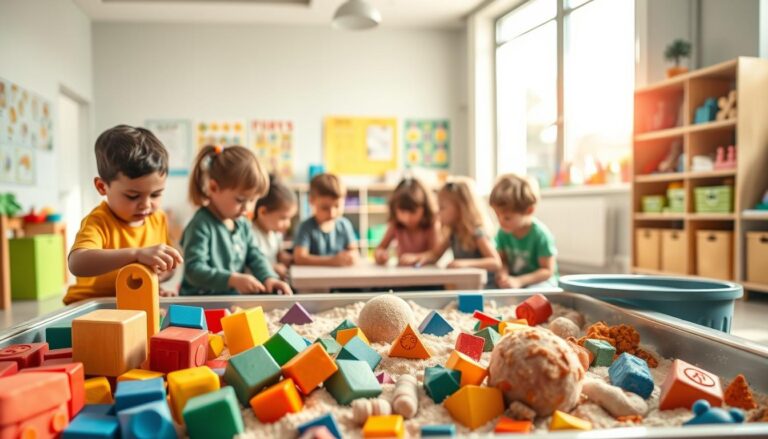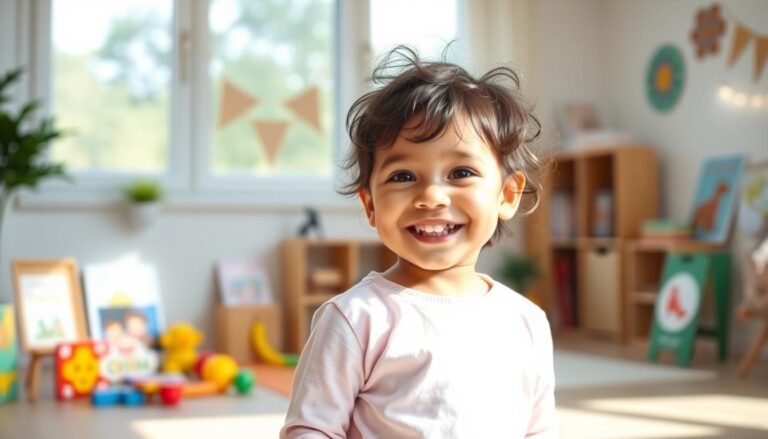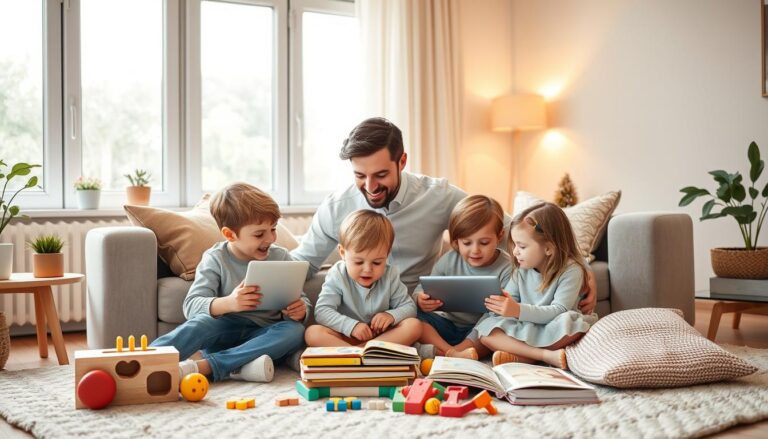Are you finding it challenging to maintain order in your classroom? Preschoolers Behavior Management can be tough for teachers and caregivers. However, there’s a way to navigate these challenges effectively. Our guide offers expert tips to transform your preschool into a thriving environment for learning and growth.
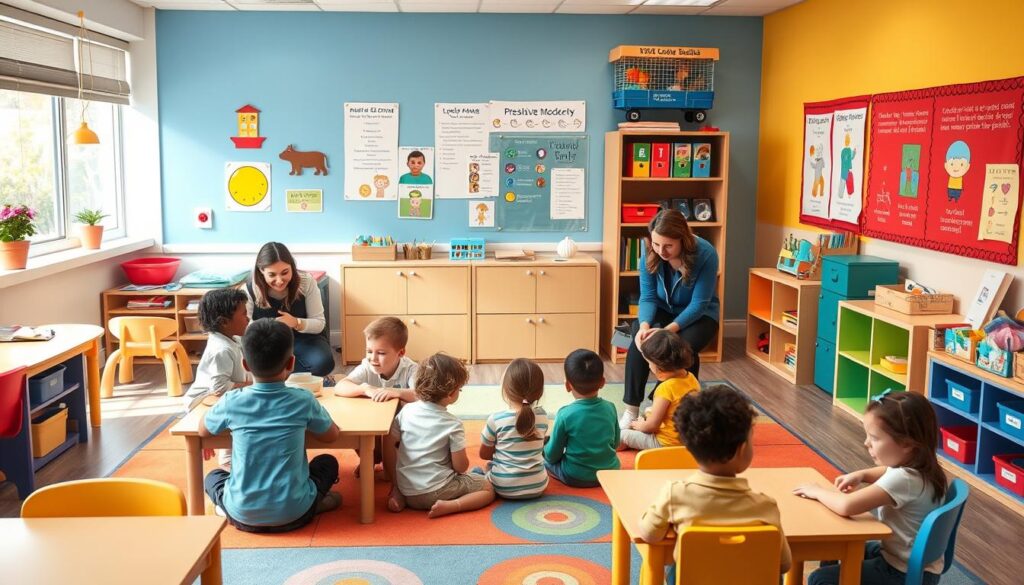
Key Takeaways
- Understand the developmental stages and expected behaviors of preschoolers
- Identify common behavioral challenges and their underlying factors
- Create a positive learning environment that fosters social-emotional development
- Implement evidence-based behavior management techniques
- Develop effective communication and conflict resolution skills
Understanding Early Childhood Behavior Patterns
Exploring the world of preschoolers’ behaviors is an exciting journey for teachers and parents. It’s key to grasp the usual behavior patterns and developmental milestones at this age. This knowledge helps create a caring and supportive space for them.
Developmental Stages and Expected Behaviors
Children from 3 to 5 years old show many behaviors. These are influenced by their social-emotional development. They might want to do things on their own, talk better, and use their imagination more.
But, they also face challenging behaviors like throwing tantrums, acting without thinking, and not wanting to share.
Common Behavioral Challenges in Preschoolers
- Difficulty regulating emotions and managing frustration
- Resistance to following instructions or following rules
- Attention-seeking behaviors, such as interrupting or disrupting activities
- Aggressive tendencies, including hitting, biting, or pushing
- Struggles with sharing toys and taking turns
Factors Influencing Child Behavior
Many things shape a preschooler’s behavior patterns. These include:
- Temperament and individual differences
- Family dynamics and parenting styles
- Environmental factors, such as classroom setup and peer interactions
- Exposure to stress, trauma, or adverse life experiences
- Developmental delays or special needs
Knowing these factors helps teachers and parents make plans to help with behavior patterns. It supports the child development of preschoolers.
Creating a Positive Learning Environment
Creating a positive classroom is key for preschoolers. It helps with social awareness, clear rules, and good behavior. A supportive place helps kids grow and learn important social and emotional skills.
Teaching social awareness is important. Preschoolers learn a lot about being social at this age. Activities that help them work together and talk about feelings are great. They help build a sense of community.
It’s also important to have clear expectations for behavior. Kids do better when they know what’s expected. Setting rules helps make the classroom a safe and predictable place. When kids help make these rules, they feel more responsible and positive.
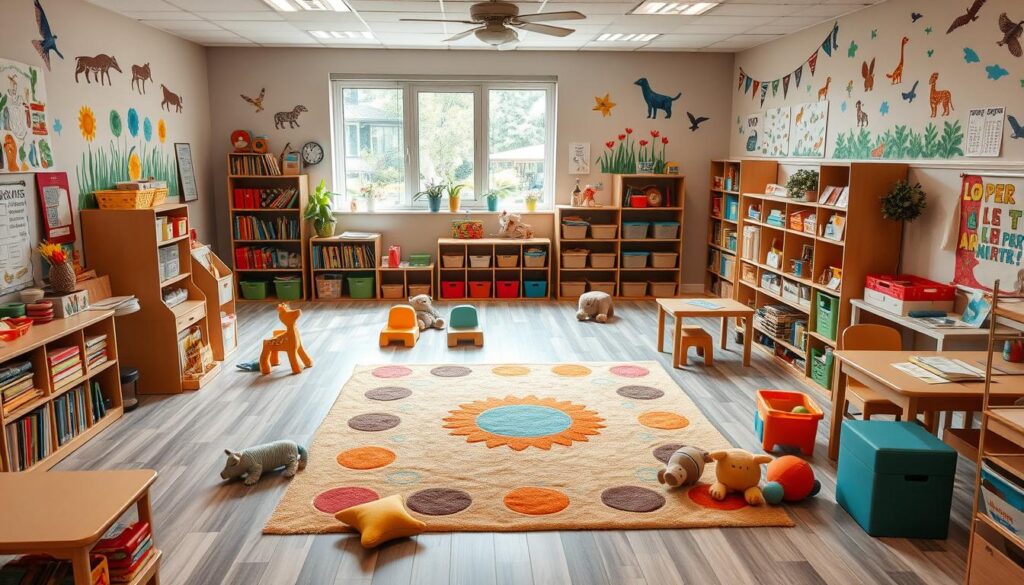
A supportive atmosphere is also vital. It celebrates what each child can do and encourages good behavior. When kids feel valued, they learn more and behave better. Praising them for good actions helps make the classroom a positive place.
By focusing on social awareness, clear rules, and a supportive atmosphere, teachers can make a positive learning environment. This helps preschoolers do well in school, with friends, and emotionally.
Essential Strategies for Preschoolers Behavior Management
Managing behavior in preschool classrooms is key for a positive learning space. Using preventive, reactive, and routine strategies helps young children grow. Let’s dive into these important methods.
Preventive Behavior Management Techniques
Preventive strategies stop problems before they start. This means setting clear rules and giving lots of positive feedback. By doing this, teachers can avoid big issues and keep the classroom calm.
Reactive Management Approaches
Even with the best plans, problems can happen. When they do, teachers use reactive strategies. This includes setting consequences and helping kids think about their actions. It teaches them to control their behavior.
Building Consistent Routines
Having set classroom routines is vital. Routines make kids feel safe and focused. They help keep the classroom running smoothly, from start to finish.
| Preventive Techniques | Reactive Approaches | Consistent Routines |
|---|---|---|
| Clear expectations Consistent classroom rules Positive reinforcement strategies | Logical consequences De-escalation techniques Reflection and amends | Arrival and dismissal procedures Transitions between activities Classroom routines |
Using these strategies, teachers can make a caring and productive place for kids to learn. It helps them grow in all ways.
Implementing Effective Classroom Rules and Guidelines
Setting clear classroom rules is key in preschools. Young kids love structure and knowing what to expect. Good rules make a positive place for learning and growing.
Rules for preschoolers should be simple and match their age. They should be positive and help kids learn good habits. This way, kids learn what’s expected without feeling bad.
- Limit the number of rules to 5-7 for better retention and compliance
- Use simple, clear language that preschoolers can comprehend
- Frame rules in a positive manner, such as “Keep hands to yourself” instead of “No hitting”
- Involve children in the rule-setting process to foster a sense of ownership and investment
It’s important to stick to these rules every day. Teachers should often talk about the rules with kids. They should also show good behavior and praise kids when they follow the rules.
| Effective Classroom Rules | Ineffective Classroom Rules |
|---|---|
| Listen to the teacher Keep hands and feet to yourself Use inside voices Take care of our classroom Follow directions the first time | No running in the classroom Don’t be mean to your friends Avoid making a mess Always do what the teacher says Be a good student |
By using the right classroom rules, teachers can create a safe and caring place for learning. This helps preschoolers meet their behavior goals.
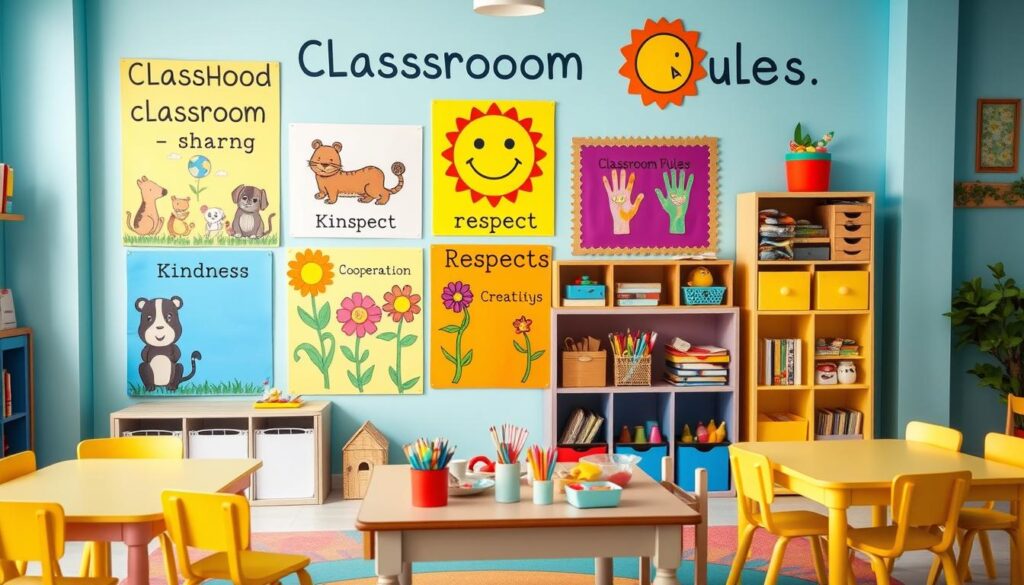
Social-Emotional Learning in Early Childhood
As educators, we know how big of an impact social-emotional learning (SEL) has. It shapes a child’s development and helps manage their behavior. By teaching emotional intelligence, social skills, and self-regulation, we help preschoolers feel confident and strong.
Developing Emotional Intelligence
Emotional intelligence helps kids understand and handle their feelings well. We use special activities and talks to help them. This way, they learn to feel empathy and control their emotions.
This not only helps them behave better but also helps them make friends and do well in school.
Building Social Skills
Preschool is key for learning social skills like talking, working together, and solving problems. We give kids chances to play together, act out roles, and talk in groups. This helps them make friends and get ready for school and life.
Teaching Self-Regulation
Self-regulation means managing your thoughts, feelings, and actions. We teach kids calming tricks, problem-solving, and positive feedback. This helps them control themselves and make good choices.
This is important for their behavior and helps them succeed in the future.
| Skill | Description | Benefits |
|---|---|---|
| Emotional Intelligence | The ability to identify, understand, and manage emotions | Supports positive behavior, enhances relationships, and promotes academic success |
| Social Skills | Communication, cooperation, and conflict resolution abilities | Fosters meaningful relationships, enhances behavior management, and prepares for future success |
| Self-Regulation | The capacity to control one’s thoughts, emotions, and behaviors | Promotes responsible decision-making, supports overall behavior management, and enables long-term success |
By focusing on these important skills early, we give preschoolers the tools they need. They learn to be confident, empathetic, and self-controlled. As teachers, we aim to help kids grow in all ways, preparing them for a bright future.
Managing Transitions and Daily Routines
Managing transitions and daily routines is key in preschool behavior management. Transitions, like moving from one activity to another, can be tough for young kids. They often lead to disruptions and unwanted behaviors. By using smart strategies, teachers can make these transitions smoother and keep the classroom positive.
Using visual cues is a great way to help kids through transitions. This can be timers, schedules, or visual signals. They help kids know what’s next. This way, preschoolers can get ready for changes and behave better.
Having a structured day and a predictable classroom helps too. Clear instructions, time limits, and consistent language help kids move between tasks easily. Adding fun activities, like singing songs or playing games, makes transitions more fun for kids.
It’s also important to think ahead and plan for challenges. Knowing what might cause problems helps teachers prepare. They can offer extra help or work one-on-one with kids who need it.
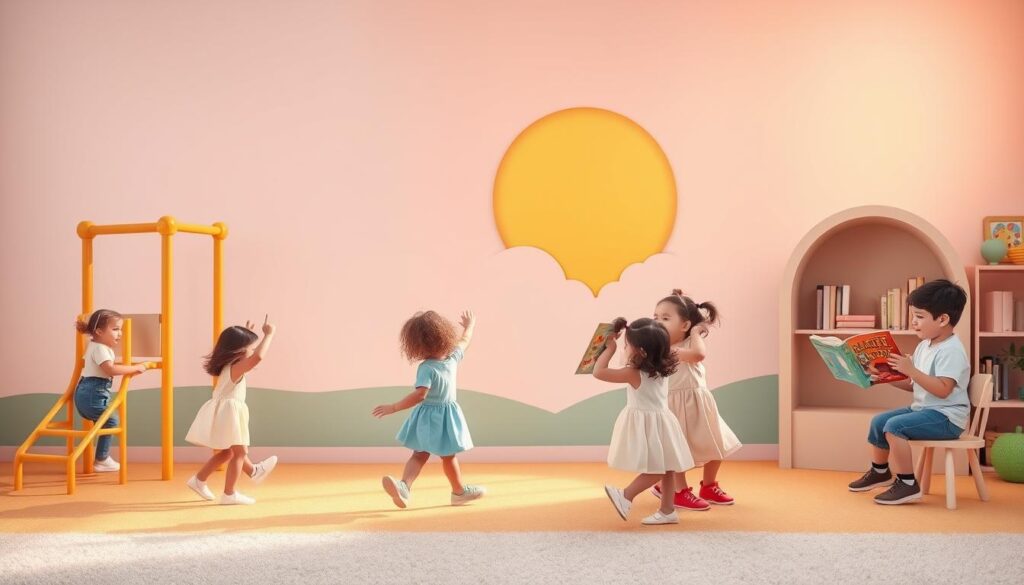
Managing transitions and daily routines in preschool needs a few strategies. Using visual cues, structuring activities, and planning for challenges helps. This way, teachers can create a positive and predictable place. It supports kids’ behavior and makes the classroom a productive place.
Positive Reinforcement Techniques
We know how important positive reinforcement is for preschoolers. It helps with child motivation, behavior recognition, and building good habits. Let’s look at the best ways to use these techniques with preschoolers.
Reward Systems That Work
A good reward system can really help young children. Try using a token economy. Kids earn stickers or points for good behavior. Then, they can trade these for fun things or small prizes.
Praise and Recognition Strategies
Verbal praise is key in preschool. When a child does something good, say so. Be specific and sincere. This makes them want to do it again.
Also, celebrate small wins. Like when they share or clean up. It boosts their self-esteem and keeps them on the right path.
Building Self-Esteem Through Positive Feedback
- Focus on what they do well, not what they don’t.
- Value their effort and progress, not just the outcome.
- Give them chances to succeed and feel proud.
- Make mistakes learning opportunities, not failures.
Using these positive reinforcement methods helps create a supportive environment. It makes preschoolers feel good about themselves and want to keep being positive. Just remember, each child is different, so adjust your approach to fit their needs.
Handling Challenging Behaviors Effectively
Preschoolers sometimes show tough behaviors that need careful handling. As teachers, we must have a smart plan to tackle these issues. By figuring out why these behaviors happen and using good classroom observation, we can make behavior intervention plans just for them.
First, we need to find out what makes these behaviors happen. Classroom observation helps us see patterns and what leads to these issues. By watching how the child acts, what’s around them, and how they feel, we can find the real problems. Then, we can make plans to fix them.
- Set clear rules and expectations: Tell your students what you expect and stick to it all day.
- Use positive ways to help: Reward good behavior, use signs, and calm activities to help kids control themselves.
- Work with families: Share what you see and work together to help the child.
- Get help when needed: Talk to school counselors or experts to make a special behavior intervention plan for the child.
By being systematic and caring in how we handle tough behaviors, we can make a better learning place. This place helps all our preschool students grow and do well in school.
“Effective behavior management in the early childhood classroom requires a balance of understanding, empathy, and consistent, evidence-based strategies.” – Dr. Jane Doe, Early Childhood Education Expert
Communication Strategies with Preschoolers
Good communication is key to strong relationships and positive interactions with preschoolers. Teachers can use active listening, non-verbal signs, and ways to solve conflicts. This helps create a caring place for young learners to grow.
Active Listening Techniques
Teachers need to listen well to understand preschool students. They should keep eye contact, repeat what they heard, and ask questions. This shows they care and helps build trust.
Non-Verbal Communication Methods
Non-verbal signs are important too. Facial expressions, body language, and voice tone show feelings and plans. Teachers should use these signs to make a friendly space for learning and feeling.
Conflict Resolution Skills
Young kids will face conflicts as they learn to get along. Teachers can help by showing how to listen and solve problems together. This teaches kids to handle disagreements well and builds important social skills.
| Communication Technique | Description | Benefits |
|---|---|---|
| Active Listening | Maintaining eye contact, rephrasing key points, and asking open-ended questions to encourage children to express their thoughts and feelings. | Establishes trust, demonstrates empathy, and encourages open communication. |
| Non-Verbal Communication | Utilizing facial expressions, body language, and tone of voice to convey emotions and intentions. | Creates a warm and welcoming environment, fosters social skills and empathy. |
| Conflict Resolution | Guiding children through challenges by modeling effective communication strategies, identifying emotions, and collaborating to find solutions. | Empowers children to resolve conflicts constructively, develops essential social skills. |
“Effective communication is not just about what we say, but how we say it. By incorporating active listening, non-verbal cues, and conflict resolution skills, preschool teachers can create a nurturing environment that supports the holistic development of young learners.”
Creating Individual Behavior Plans
Managing preschoolers’ behavior needs a personal touch. Making behavior plans for each child is key. These plans help track and support good behavior development in school and at home.
To start a behavior plan, you must do a detailed child behavior assessment. This means watching the child, finding patterns, and figuring out why they act certain ways. With all this info, you can make a plan that really works for the child.
- Use behavior tracking systems to keep records of what the child does, what makes them act out, and how they react.
- Work with the child, parents, and others to set clear, reachable goals for better behavior.
- Make a plan that includes ways to prevent problems, rewards for good behavior, and how to handle bad behavior.
It’s important to check how well the behavior plan is working often. Teachers should look at the child’s progress, change the plan if needed, and celebrate their wins. This way, preschoolers can grow the social and emotional skills they need for the future.
“Tailoring behavior plans to individual needs empowers children to thrive and reach their full behavior development.”
Building Strong Teacher-Child Relationships
It’s very important for teachers to have a good relationship with their students. This helps manage behavior in preschool. Teachers need to build trust, emotional bonds, and understand each child’s needs. This makes the classroom a supportive place for learning.
Trust-Building Activities
Starting with trust-building activities is key. Teachers can play games, share stories, and listen to kids. These actions make kids feel important and safe in school.
Creating Emotional Connections
Teachers should show care and empathy to build strong bonds. By being genuinely interested in kids’ lives, teachers create a sense of belonging. Regular check-ins and celebrating successes help too.
Supporting Individual Needs
Every child is different, and teachers need to recognize this. They should learn about each child’s learning style and challenges. This helps tailor teaching and support to meet each child’s needs.
| Strategies for Building Strong Teacher-Child Relationships | Benefits |
|---|---|
| Engage in trust-building activities Create emotional connections through empathy and care Support individual needs and learning styles | Promotes positive classroom environment Enhances child engagement and learning Reduces behavioral challenges Fosters a sense of security and belonging |
Teachers who focus on building strong relationships help manage preschool behavior well. Trust, emotional bonds, and personalized support create a positive learning space. This helps kids do well in school and socially.
Promoting Independence and Autonomy
As preschoolers grow, it’s key to help them feel independent and in control. This helps them grow and feel good about themselves. Teachers can help by letting them make choices and do things on their own.
Letting preschoolers explore and decide things for themselves is a great way to start. They can pick what to do, what materials to use, or even plan their day. This helps them feel in charge and connected to their learning space.
- Offer choices: Give preschoolers options, like what activity to do or which materials to use, and let them decide.
- Encourage self-help skills: Teach them to dress, use the restroom, and clean up. This makes them feel capable of taking care of themselves.
- Promote classroom participation: Start discussions and ask questions that encourage them to share their thoughts and ideas.
Also, having set routines helps preschoolers feel secure and in control. Knowing what to expect makes them feel more at ease in the classroom.
“The greatest gifts we can give children are the roots of responsibility and the wings of independence.”
– Maria Montessori
By using these methods, teachers can create a classroom that supports independence and active learning. This leads to better behavior and growth in preschoolers.
Classroom Organization and Management Tips
Keeping a classroom tidy and well-managed is key for a good learning space for preschoolers. This section shares tips for setting up fun activity centers, managing materials, and using visual schedules. These help with good behavior and learning.
Setting Up Activity Centers
Splitting the classroom into areas like a reading nook and arts and crafts helps kids stay on track. Make sure each area has the right stuff for their age. Use signs or pictures to show how to use things.
Managing Materials and Resources
Good management of classroom stuff makes learning better. Use labels and bins to keep things neat. Let kids help clean up to teach them about taking care of things.
Creating Visual Schedules
Visual schedules help kids know what’s happening next. Use pictures or simple drawings to show the day’s plan. This makes kids feel safe and less likely to act out when things change.
FAQ
What are the common behavioral challenges in preschoolers?
Preschoolers often face challenges like being too loud or having trouble focusing. They might also struggle with making friends or controlling their impulses.
How can I create a positive learning environment for preschoolers?
To make a positive learning space, focus on teaching social skills. Set clear rules and create a supportive atmosphere. This helps kids grow and behave well.
What are some essential strategies for managing preschoolers’ behavior?
Key strategies include preventing bad behavior and using quick fixes when needed. Also, having a regular schedule helps keep things calm.
Why is social-emotional learning important in early childhood?
Learning about feelings and social skills is vital for young kids. It helps them manage their emotions and get along with others.
How can I effectively manage transitions and daily routines in a preschool classroom?
Use signs and clear plans to help kids move smoothly between activities. This keeps things running smoothly and helps kids behave well.
What are some effective positive reinforcement techniques for preschoolers?
Rewarding good behavior and praising kids works well. It boosts their self-confidence and encourages them to act well.
How can I communicate effectively with preschoolers?
Listen well and use simple words to talk to kids. Also, teach them how to solve problems without fighting. This helps everyone get along.
Why is it important to build strong teacher-child relationships in behavior management?
A good bond between teachers and kids is key. It builds trust and helps kids feel safe and supported.
How can I promote independence and autonomy in preschoolers?
Encourage kids to do things on their own. Let them make choices and join in activities. This helps them grow and behave better.
What are some tips for organizing and managing a preschool classroom effectively?
Set up fun learning areas and keep things tidy. Use schedules to help kids stay on track. This makes learning fun and helps them behave.
